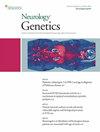CSF1R 相关疾病的全球存在性和普遍性。
IF 3
3区 医学
Q2 CLINICAL NEUROLOGY
引用次数: 0
摘要
方法 收集全球患者的数据,包括人口统计学、基因型、家族史和临床状况。为了进行单倍型分析,研究了3个不同的CSF1R p.Ile794Thr变异家庭中短串联重复序列的多态性。结果共纳入19名新患者,平均年龄38.7岁(11至74岁不等),来自美洲、亚洲、澳大利亚和欧洲的14个家庭,其中包括墨西哥、北马其顿和乌克兰的首例患者。共发现15个CSF1R变异体,包括8个新型变异体。三名患者为复合杂合子,发病年龄分别为1岁、4岁和22岁。CSF1R杂合子变异体患者平均在39.0岁(8-71岁)时出现症状。四名患者在发病后平均 3.3 年(2-5 年)死亡。7 名患者无家族史。在单倍型分析中,2 个家族显示出包含 CSF1R 下游 6-Mb 区域的共享单倍型,而第三个家族则显示出不同的单倍型。CSF1R-RD在全球普遍存在,其家族史阴性的原因包括从头变异(如单倍型分析所示)、镶嵌和不完全渗透,这些可能受到环境和遗传因素的影响。本文章由计算机程序翻译,如有差异,请以英文原文为准。
Global Presence and Penetrance of CSF1R-Related Disorder.
Objectives
To highlight the worldwide presence of CSF1R-related disorder (CSF1R-RD), discuss its penetrance, and provide the first haplotype analysis.
Methods
Data on patients worldwide were collected, including demographics, genotype, family history, and clinical status. For haplotype analysis, polymorphisms of short tandem repeats in 3 distinct families with CSF1R p.Ile794Thr variant were examined.
Results
Nineteen new patients were included, at a mean age of 38.7 years (ranging from 11 to 74 years), from 14 families from the Americas, Asia, Australia, and Europe, including the first from Mexico, North Macedonia, and Ukraine. Fifteen CSF1R variants were found, including 8 novel. Three patients were compound heterozygotes with disease onset at 1, 4, and 22 years. Patients with heterozygous CSF1R variants developed symptoms at a mean of 39.0 years (range 8-71 years). Four patients died at a mean of 3.3 years from onset (range 2-5 years). Negative family history was noted in 7 patients. In haplotype analysis, 2 families exhibited shared haplotype encompassing ∼6-Mb region downstream of the CSF1R while the third family displayed a different haplotype.
Discussion
CSF1R-RD has a global prevalence. The reasons for negative family history include de novo variants (as shown by the haplotype analysis), mosaicism, and incomplete penetrance, which are possibly modulated by environmental and genetic factors.
求助全文
通过发布文献求助,成功后即可免费获取论文全文。
去求助
来源期刊

Neurology-Genetics
Medicine-Neurology (clinical)
CiteScore
6.30
自引率
3.20%
发文量
107
审稿时长
15 weeks
期刊介绍:
Neurology: Genetics is an online open access journal publishing peer-reviewed reports in the field of neurogenetics. Original articles in all areas of neurogenetics will be published including rare and common genetic variation, genotype-phenotype correlations, outlier phenotypes as a result of mutations in known disease-genes, and genetic variations with a putative link to diseases. This will include studies reporting on genetic disease risk and pharmacogenomics. In addition, Neurology: Genetics will publish results of gene-based clinical trials (viral, ASO, etc.). Genetically engineered model systems are not a primary focus of Neurology: Genetics, but studies using model systems for treatment trials are welcome, including well-powered studies reporting negative results.
 求助内容:
求助内容: 应助结果提醒方式:
应助结果提醒方式:


